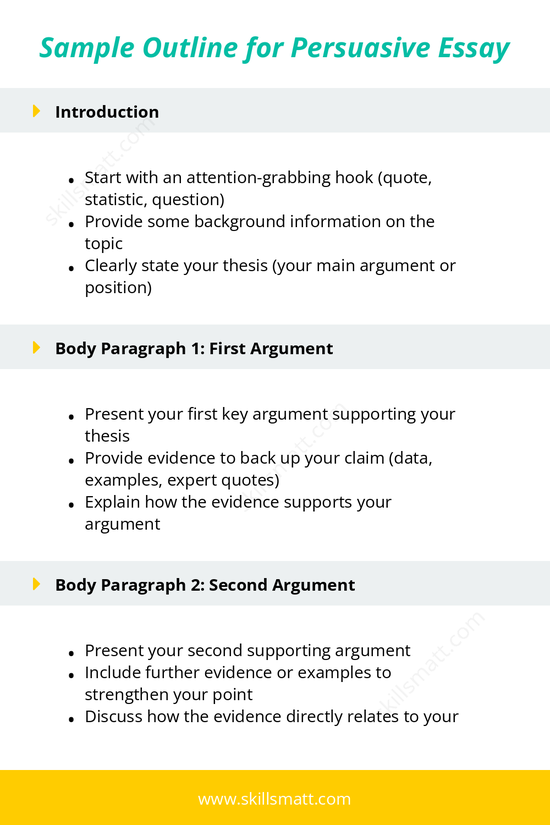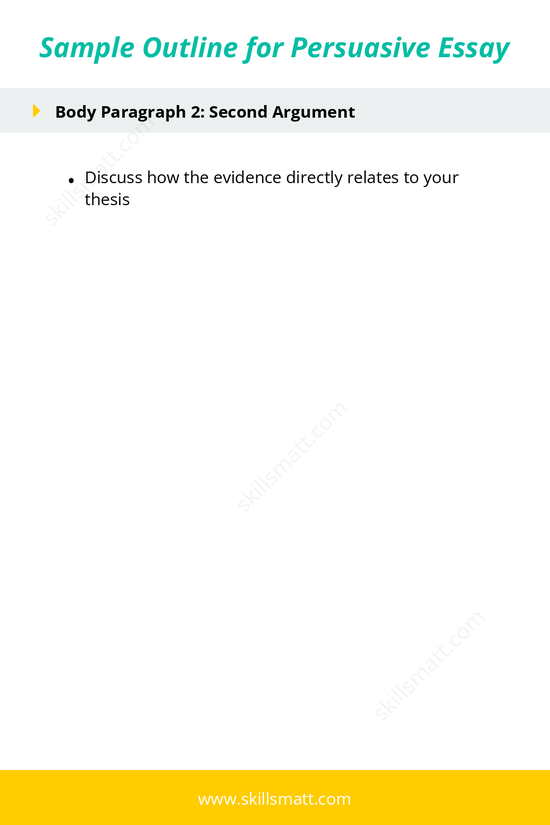When writing a persuasive essay, it’s essential to create a structured outline to organize your ideas and arguments. A well-organized outline helps guide your writing process and ensures your essay is both coherent and compelling. Below is a sample outline for a persuasive essay that you can follow for your next assignment.
Introduction
The introduction is your first opportunity to capture the reader's attention and present your thesis. A strong introduction sets the stage for the rest of your essay.
- Start with an attention-grabbing hook (quote, statistic, question): Begin with something that catches the reader’s attention, such as an interesting quote, a surprising statistic, or a thought-provoking question related to your topic.
- Provide some background information on the topic: After the hook, provide some context to help the reader understand the issue. This can include a brief history, definition, or overview of the topic.
- Clearly state your thesis (your main argument or position): End the introduction with a concise thesis statement that clearly presents your position on the topic.
Body Paragraph 1: First Argument
The first body paragraph introduces your strongest argument. This is where you present the first key reason why your thesis is valid.
- Present your first key argument supporting your thesis: Clearly state your first supporting argument. This should be a strong reason that backs up your thesis statement.
- Provide evidence to back up your claim (data, examples, expert quotes): Support your argument with credible evidence, such as facts, examples, or expert opinions.
- Explain how the evidence supports your argument: After presenting your evidence, explain how it strengthens your case and ties back to your thesis.
Body Paragraph 2: Second Argument
The second body paragraph builds on your argument by introducing another reason supporting your thesis.
- Present your second supporting argument: Introduce a second reason why your thesis is correct.
- Include further evidence or examples to strengthen your point: Provide additional evidence or examples that solidify your second argument.
- Discuss how the evidence directly relates to your thesis: Explain the relevance of the evidence and how it supports your overall position.
Body Paragraph 3: Third Argument
The third body paragraph presents another argument supporting your thesis. This adds more weight to your position and reinforces your overall argument.
- Introduce your third supporting argument: Present another reason that strengthens your case.
- Provide supporting facts or examples that reinforce your position: Use relevant facts, data, or examples that back up this third argument.
- Clarify how this argument ties into the overall argument: Tie the argument back to your thesis, showing how it contributes to your overall position.
Counterargument and Refutation
Every persuasive essay should address opposing viewpoints. Acknowledging and refuting counterarguments strengthens your position and shows that you've considered multiple perspectives.
- Acknowledge an opposing viewpoint: Present a common counterargument or opposing view to your position.
- Refute the counterargument with logic, reasoning, or evidence: Use logical reasoning or evidence to show why the opposing viewpoint is less valid than your argument.
- Reaffirm why your thesis is stronger than the counterargument: End by explaining why your thesis remains the stronger position despite the counterargument.
Conclusion
The conclusion wraps up your essay by restating your thesis and reinforcing the importance of your argument. It’s your final chance to leave a lasting impression on the reader.
- Restate your thesis in a new way to reinforce your position: Restate your thesis in a way that emphasizes its validity based on the arguments you've presented.
- Summarize the key points made in the body paragraphs: Provide a brief summary of the key arguments you made, reminding the reader of the strength of your position.
- End with a strong closing statement or call to action: Finish with a powerful statement that either leaves the reader thinking or calls them to take action regarding your argument.
By following this outline, you can ensure your persuasive essay is structured logically and persuasively, providing a strong case for your position. Always remember to support your arguments with credible evidence and refute counterarguments thoughtfully to strengthen your overall essay.


